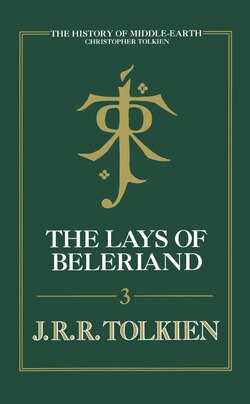Читать книгу The Lays of Beleriand - Christopher Tolkien - Страница 7
ОглавлениеPREFACE
This third part of ‘The History of Middle-earth’ contains the two major poems by J. R. R. Tolkien concerned with the legends of the Elder Days: the Lay of the Children of Húrin in alliterative verse, and the Lay of Leithian in octosyllabic couplets. The alliterative poem was composed while my father held appointments at the University of Leeds (1920–5); he abandoned it for the Lay of Leithian at the end of that time, and never turned to it again. I have found no reference to it in any letter or other writing of his that has survived (other than the few words cited on p. 3), and I do not recollect his ever speaking of it. But this poem, which though extending to more than 2000 lines is only a fragment in relation to what he once planned, is the most sustained embodiment of his abiding love of the resonance and richness of sound that might be achieved in the ancient English metre. It marks also an important stage in the evolution of the Matter of the Elder Days, and contains passages that strongly illumine his imagination of Beleriand; it was, for example, in this poem that the great redoubt of Nargothrond arose from the primitive caves of the Rodothlim in the Lost Tales, and only in this poem was Nargothrond described. It exists in two versions, the second being a revision and enlargement that proceeds much less far into the story, and both are given in this book.
My father worked on the Lay of Leithian for six years, abandoning it in its turn in September 1931. In 1929 it was read so far as it then went by C. S. Lewis, who sent him a most ingenious commentary on a part of it; I acknowledge with thanks the permission of C. S. Lewis PTE Limited to include this.
In 1937 he said in a letter that ‘in spite of certain virtuous passages’ the Lay of Leithian had ‘grave defects’ (see p. 366). A decade or more later, he received a detailed, and remarkably unconstrained, criticism of the poem from someone who knew and admired his poetry. I do not know for certain who this was. In choosing ‘the staple octosyllabic couplet of romance,’ he wrote, my father had chosen one of the most difficult of forms ‘if one wishes to avoid monotony and sing-song in a very long poem. I am often astonished by your success, but it is by no means consistently maintained.’ His strictures on the diction of the Lay included archaisms so archaic that they needed annotation, distorted order, use of emphatic doth or did where there is no emphasis, and language sometimes flat and conventional (in contrast to passages of ‘gorgeous description’). There is no record of what my father thought of this criticism (written when The Lord of the Rings was already completed), but it must be associated in some way with the fact that in 1949 or 1950 he returned to the Lay of Leithian and began a revision that soon became virtually a new poem; and relatively little though he wrote of it, its advance on the old version in all those respects in which that had been censured is so great as to give it a sad prominence in the long list of his works that might have been. The new Lay is included in this book, and a page from a fine manuscript of it is reproduced as frontispiece.
The sections of both poems are interleaved with commentaries which are primarily concerned to trace the evolution of the legends and the lands they are set in.
The two pages reproduced from the Lay of the Children of Húrin (p. 15) are from the original manuscript of the first version, lines 297–317 and 318–33. For differences between the readings of the manuscript and those of the printed text see pp. 4–5. The page from the Lay of Leithian in Elvish script (p. 299) comes from the ‘A’ version of the original Lay (see pp. 150–1), and there are certain differences in the text from the ‘B’ version which is that printed. These pages from the original manuscripts are reproduced with the permission of the Bodleian Library, Oxford, and I thank the staff of the Department of Western Manuscripts at the Bodleian for their assistance.
The two earlier volumes in this series (the first and second parts of The Book of Lost Tales) are referred to as ‘I’ and ‘II’. The fourth volume will contain the ‘Sketch of the Mythology’ (1926), from which the Silmarillion ‘tradition’ derived; the Quenta Noldorinwa or History of the Noldoli (1930); the first map of the North-west of Middle-earth; the Ambarkanta (‘Shape of the World’) by Rúmil, together with the only existing maps of the entire World; the earliest Annals of Valinor and Annals of Beleriand, by Pengolod the Wise of Gondolin; and the fragments of translations of the Quenta and Annals from Elvish into Anglo-Saxon by Ælfwine of England.
